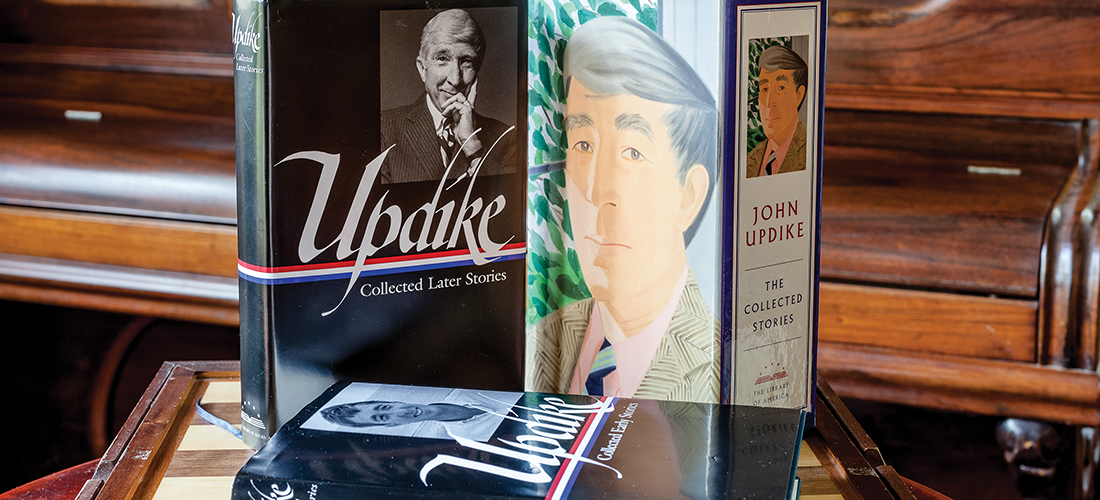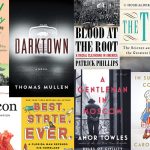
A collection of 186 stories and a new biography are a chance to reexamine a remarkable literary life
By Stephen E. Smith
In his biography Updike, Adam Begley quotes from a letter John Updike wrote to his mother while he was a student at Harvard: “We need a writer who desires both to be great and to be popular, an author who can see America as clearly as Sinclair Lewis, but, unlike Lewis, is willing to take it to his bosom.”
Updike was describing the writer he’d become. For more than 50 years his novels, essays, poems and short stories filled America’s bookshelves, and the upper middle class, the culturati from which he drew his characters and themes, received each new volume with enthusiasm.
When Updike died of lung cancer in 2009 (addiction trumped intellect), we were left with 30 novels, 15 short story collections and umpteen books of poetry and assorted prose to appreciate anew. With the publication of Library of America’s quality two-volume edition (a boxed set) and Begley’s biography, Updike, readers have an opportunity to read or reread 186 stories (the Bech and Maples stories are published in separate volumes) arranged in order of publication. Astute readers can correlate the stories with Begley’s exposition of Updike’s richly complex life as an observer and participant in the subculture about which he wrote with extravagance and often shocking excess. Best remembered for his “Rabbit” novels, it’s Updike’s short stories, most of which were published in The New Yorker, that most closely parallel the life he lived.
Begley is quick to point out that few American fiction writers were more autobiographical than Updike — so obsessively so as to raise questions about Updike’s capacity for rational detachment. Readers unfamiliar with his short fiction are forewarned that his dominant theme is betrayal and its resultant complexities. His characters are white, usually Protestant members of the American upper middle class living in southeastern Pennsylvania or New England. His subject is adultery. The operative emotion is guilt, as explained in his 1977 story “Guilt-Gems”: “A guilt-gem is a piece of the world that has volunteered for compression. Those souls around us, living our lives with us, are gaseous clouds of being awaiting a condensation and preservation — faces, lights that glimmer out, somehow not seized, saved in the gesture and remorse.”
Updike is the master of The New Yorker short story, carefully wrought prose narratives with lengthy passages of description and meticulously rendered characters who find themselves unhappy in a world of affluence that encourages the guilty pleasures of adultery. So pervasive is this mindset that in “The Women Who Got Away” the narrator is touched with exquisite regret for potential affairs he failed to consummate: “There were women you failed ever to sleep with; these, in retrospect, have a perverse vividness, perhaps because the contacts, in the slithering ball of snakes, were so few that they have stayed distinct.”
For all of his literary sophistication, Updike is the most parochial of writers. With a few possible exceptions — most especially his story “Varieties of Religious Experience” (a real clunker) — he wisely sticks to what he knows. Southern readers won’t discover tobacco worms, hogs and banjo-picking rednecks in his fiction (although there’s an occasional working-class hero), and his characters are, after the similitude of their re-embodiment in story after story, possessed of a mildly annoying self-indulgence and an irritating dissatisfaction with bourgeois abundance.
Moreover, the focus on the purely carnal is likely to wear thin when the stories are read without interruption. Even the most voyeuristic of readers are likely to experience a vague unease. Certainly sex has much to do with our lives, but at what point is the committed imagination overwhelmed by irrational obsession? Guilt experienced vicariously may have a temporary exhilarating effect on the reader, but it’s accompanied by a sense of sorrow at having benefited emotionally at the expense of others. This becomes especially apparent when Begley reveals Updike’s serial adultery, a philandering so obsessive that Updike was immensely proud of having made love to three women in one day, all the while living a life in which he remained a civic luminary and held responsible stations in various Protestant churches.
In the final analysis, however, Updike is more than a horndog with a thesaurus. In conveying memorable life moments, true and full of empathy, and producing examples of sense experience used to good effect, he is unsurpassed. The poignant, knifing nuances of life permeate his fiction, as with this typical passage from a pedantically sexual visit to a dental hygienist in “Tristan and Iseult”: “Sometimes his roving eyes flicked into her own, then leaped away, overwhelmed by their glory, their — as the deconstructionists say — presence. His glance didn’t dare linger even long enough to register the color of these eyes; he gathered only the spiritual, starlike afterimage of their living gel, simultaneously crystalline and watery, behind the double barrier of her glasses and safety goggles, above the shield-shaped paper mask hiding her mouth, her chin, her nostrils. So much of her was enwrapped, protected. Only her essentials were allowed to emerge, like a barnacle’s feathery appendages, her touch and her steadfast, humorless gaze.” Updike is tirelessly observant, and any careful reader of his fiction is bound to wonder if there’s an emotion, gesture or technical detail that’s gone unexplored.
Updike’s early stories are a study in the evolution of the great writer he would become, and the later stories are often burdened with excess detail and Jamesian syntactical constructs that leave the reader yearning for a misplaced comma or a dangling modifier. The less ambitious middle stories — most notably those included in the collections “Museums and Women” and “Trust Me” — are varied in subject matter and more experimental in structure and execution. “The Orphaned Swimming Pool,” “Invention of the Horse Collar,” “Poker Night,” “Under the Microscope,” “Museums and Women,” “During the Jurassic,” “The Baluchitherium,” “The Slump” and “Still of Some Use” are departures from Updike’s formulaic adultery fiction. They’re overlooked gems that avoid the quirky, distracting The New Yorker ending and are more immediately appreciated.
Updike became the writer he described in that long ago letter to his mother. A large segment of the American public took him to their bosom, convinced that his vision of America was correct — or at least sufficiently believable. Whether his literary reputation will eclipse that of Sinclair Lewis’, well, that remains to be seen. PS
Stephen E. Smith is a retired professor and the author of seven books of poetry and prose. He’s the recipient of the Poetry Northwest Young Poet’s Prize, the Zoe Kincaid Brockman Prize for poetry, and four North Carolina Press awards.





